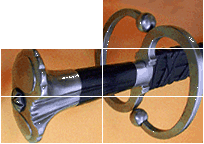ArmArt Riccard Viking Sword
Original: Norwegian, mid-9th century, Universitetets Oldsaksamling, Oslo, Norway

The Riccard Viking is based on a sword that is a grave-find in Vaage, Oppland, Norway that was documented by Jan Petersen in
De Norske Vikingsverd (1919). The hilt is a Petersen Type S (Wheeler Type III) with a Geibig Type 1 blade. Where the original was silver-plated with the pattern cut into it to reveal the iron base, this sword is decorated by smith-darkened engraving. The engravings on the cross are well-formed, though the engravings on the pommel are slightly "tilted". Originals would have inlays of silver, copper or niello. The fuller terminates one-inch from the spatulate tip. The grip is of leather cord and is very comfortable on the hand. The five-lobed pommel is accented with silver wire.
This sword is a dedicated cutter, typical of the swords of the period. The grip is long enough (4") for a hammer grip, but the pommel allows for a proposed "Viking grip", with the pommel resting on the "heel" of the hand. This type of grip allows for the pommel to slide along the palm to increase range with long, slashing cuts as described by Patrick Kelly in his
hands-on review of the Albion Jarl sword.
The scabbard core of walnut is covered in black-and-white calfskin. At the tip of the scabbard, the skin is drawn together with a strap. A copper clip, for hanging the scabbard on the belt, is attached to the rear side by means of two firmly wrapped leather straps.
Overall length: 37.375"
Weight: 2.8 pounds
Width of guard: 4.5"
Blade: 31.25" long; 2" wide tapering to 1.5"
Grip and pommel: 5.625"
Point of Balance (PoB): 5.75" from guard
Center of Percussion (CoP): ~20.75" from guard
Maker:
ArmArt of the Czech Republic.


